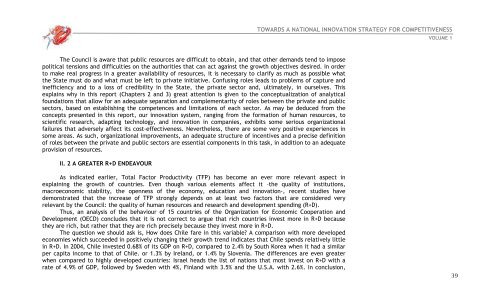Libro Blanco Vol I en Ingles
Libro Blanco Vol I en Ingles
Libro Blanco Vol I en Ingles
You also want an ePaper? Increase the reach of your titles
YUMPU automatically turns print PDFs into web optimized ePapers that Google loves.
TOWARDS A NATIONAL INNOVATION STRATEGY FOR COMPETITIVENESSVOLUME 1The Council is aware that public resources are difficult to obtain, and that other demands t<strong>en</strong>d to imposepolitical t<strong>en</strong>sions and difficulties on the authorities that can act against the growth objectives desired. In orderto make real progress in a greater availability of resources, it is necessary to clarify as much as possible whatthe State must do and what must be left to private initiative. Confusing roles leads to problems of capture andineffici<strong>en</strong>cy and to a loss of credibility in the State, the private sector and, ultimately, in ourselves. Thisexplains why in this report (Chapters 2 and 3) great att<strong>en</strong>tion is giv<strong>en</strong> to the conceptualization of analyticalfoundations that allow for an adequate separation and complem<strong>en</strong>tarity of roles betwe<strong>en</strong> the private and publicsectors, based on establishing the compet<strong>en</strong>ces and limitations of each sector. As may be deduced from theconcepts pres<strong>en</strong>ted in this report, our innovation system, ranging from the formation of human resources, tosci<strong>en</strong>tific research, adapting technology, and innovation in companies, exhibits some serious organizationalfailures that adversely affect its cost-effectiv<strong>en</strong>ess. Nevertheless, there are some very positive experi<strong>en</strong>ces insome areas. As such, organizational improvem<strong>en</strong>ts, an adequate structure of inc<strong>en</strong>tives and a precise definitionof roles betwe<strong>en</strong> the private and public sectors are ess<strong>en</strong>tial compon<strong>en</strong>ts in this task, in addition to an adequateprovision of resources.II. 2 A GREATER R+D ENDEAVOURAs indicated earlier, Total Factor Productivity (TFP) has become an ever more relevant aspect inexplaining the growth of countries. Ev<strong>en</strong> though various elem<strong>en</strong>ts affect it –the quality of institutions,macroeconomic stability, the op<strong>en</strong>ness of the economy, education and innovation-, rec<strong>en</strong>t studies havedemonstrated that the increase of TFP strongly dep<strong>en</strong>ds on at least two factors that are considered veryrelevant by the Council: the quality of human resources and research and developm<strong>en</strong>t sp<strong>en</strong>ding (R+D).Thus, an analysis of the behaviour of 15 countries of the Organization for Economic Cooperation andDevelopm<strong>en</strong>t (OECD) concludes that it is not correct to argue that rich countries invest more in R+D becausethey are rich, but rather that they are rich precisely because they invest more in R+D.The question we should ask is, How does Chile fare in this variable? A comparison with more developedeconomies which succeeded in positively changing their growth tr<strong>en</strong>d indicates that Chile sp<strong>en</strong>ds relatively littlein R+D. In 2004, Chile invested 0.68% of its GDP on R+D, compared to 2.4% by South Korea wh<strong>en</strong> it had a similarper capita income to that of Chile. or 1.3% by Ireland, or 1.4% by Slov<strong>en</strong>ia. The differ<strong>en</strong>ces are ev<strong>en</strong> greaterwh<strong>en</strong> compared to highly developed countries: Israel heads the list of nations that most invest on R+D with arate of 4.9% of GDP, followed by Swed<strong>en</strong> with 4%, Finland with 3.5% and the U.S.A. with 2.6%. In conclusion,39












![[Tam] Uygula[ya] - Bilim, Teknoloji ve Ä°novasyon Politikaları TartıÅma ...](https://img.yumpu.com/36820041/1/184x260/tam-uygulaya-bilim-teknoloji-ve-anovasyon-politikalara-tartaama-.jpg?quality=85)



